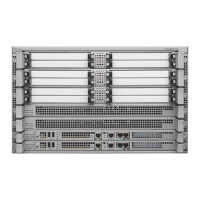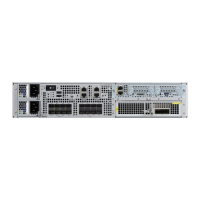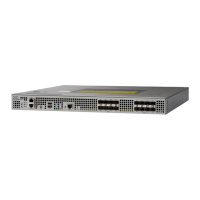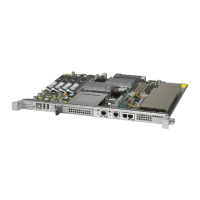27-12
Cisco ASR 1000 Series Aggregation Services Routers SIP and SPA Software Configuration Guide
OL-14127-08
Chapter 27 Classifying and Scheduling Packets for ASR 1000 Series
Information About Ingress Classification
DETAILED STEPS
Classifying MPLS Packets
To classify either all the MPLS packets or the MPLS packets based on EXP bits of the MPLS header as
either high or low, execute the following set of commands in the Configuration ingress class map mode:
Command or Action Purpose
Step 1
enable
Example:
Router> enable
Enables privileged EXEC mode. Enter your password when
prompted.
Step 2
configure terminal
Example:
Router# configure terminal
Enters global configuration mode.
Step 3
ingress-class-map 1
Example:
Router(config-ing-class-map)#
Enters the ingress classification template settings for the
specified template ID and enables the configuration of the
classifications for IPv4, IPv6, or MPLS.
Step 4
map ipv6 all queue strict-priority
Example:
Router(config-ing-class-map)# map ipv6 all
queue strict-priority
Sets the priority for all IPv6 packets as high.
Step 5
map ipv6 tc tc-value queue strict-priority
Example:
Router(config-ing-class-map)# map ipv6 tc af43
queue strict-priority
Classifies IPv6 traffic class values with af43 as high
priority.
Step 6
exit
Example:
Router(config-ing-class-map)# exit
Exits the ingress-class-map mode and goes back to the
global configuration mode.
Step 7
interface {POS | Serial} interface-path-id
Example:
Router(config)# interface POS 0/2/0
Enters the interface configuation mode and specifies the
POS or Serial interface name with the notation
slot/sub-slot/interface-id. Possible interface types for this
procedure are:
• POS
• Serial
Note The example indicates a 0 port in the POS SPA
adapter at sub-slot 2 in the SIP at slot 0.
Step 8
plim qos input class-map index-id
Example:
Router(config-if)# plim qos input class-map 1
Attaches the ingress classification class-map template with
the specified index-id to the POS or Serial interface.

